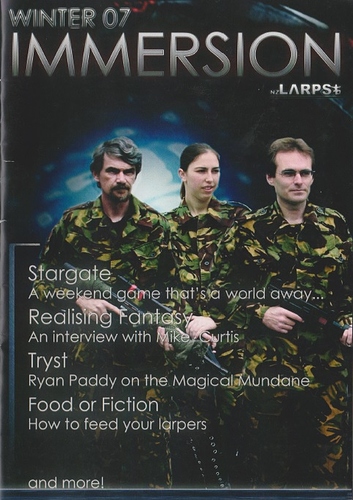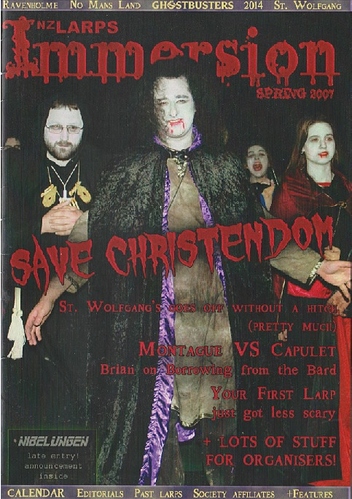Now that the entire backcatalog of Immersion, NZLARPS’ old magazine, is online, I thought I’d start an rpg.net-style “let’s read” thread bookclub to look at and discuss the highlights. Issue one has kindof been gone over in the “wanted” thread (and here). So I thought I’d start with issue two, from Autumn 2007:
So what’s in it? The usual society news, calendar, reports on games past and upcoming, and ads for affiliates. Interesting bits:
- The society news discusses a proposed growth strategy. Back then, the Auckland larp community had the problem of too many games and not enough players. This spawned an extensive discussion here on ways of growing the community, what sorts of games should be supported, and whether NZLARPS was too focused on money. Growth is still in issue in some regions, and something we should probably look at again…
- There’s a writeup for Ravenholme, a creepy gothic campaign which sounds quite interesting. People wanting to know more could delve into the archive (requires login).
- There’s also a writeup on Quest Waikato, which is still New Zealand’s longest-running larp (yes, they’re still around, though games are infrequent. They were talking about running something in the near future…)
- A couple of pieces promoting larp concepts which I don’t think happened. Its easy to come up with a campaign concept, but harder it implement it. And that’s still the case.
- A review by @Ryan_Paddy of Flight of the Hindenburg’s initial run at KapCon 2007. The game has since been rerun a couple more times, and IMHO stands up well. It’s one of the stronger theatreforms KapCon ran, and well worth playing if you get the opportunity (I have vague hopes of taking it to Phoenix sometime, if the con grows large enough to support it).
- @Wulfen_David talks about (physical) immersion vs suspension of disbelief. Nowdays, we push for immersion as much as we can, with high-quality costumes and a lot of set-dressing, because its seen as aiding suspension of disbelief: its easier to act as if you’re in not-quite-Paris or a norse longhall if the players and set look the part. Plus, it makes for cooler photos afterwards.
Read it through. Anything else strike your eye that’s worth commenting on, which makes you go “I wish I’d played that” or “this issue is still around, but…”? Then speak up!
(Also, if you’re interested in the old games mentioned in it, info can be found in the archive (requires login)).

 Its something which is IMHO an absence from the NZ larp scene. While Hydra is carrying the flame for pre-gen theatreform, its half the size, and doesn’t seem to be quite the community melting pot that Chimera was.
Its something which is IMHO an absence from the NZ larp scene. While Hydra is carrying the flame for pre-gen theatreform, its half the size, and doesn’t seem to be quite the community melting pot that Chimera was.
